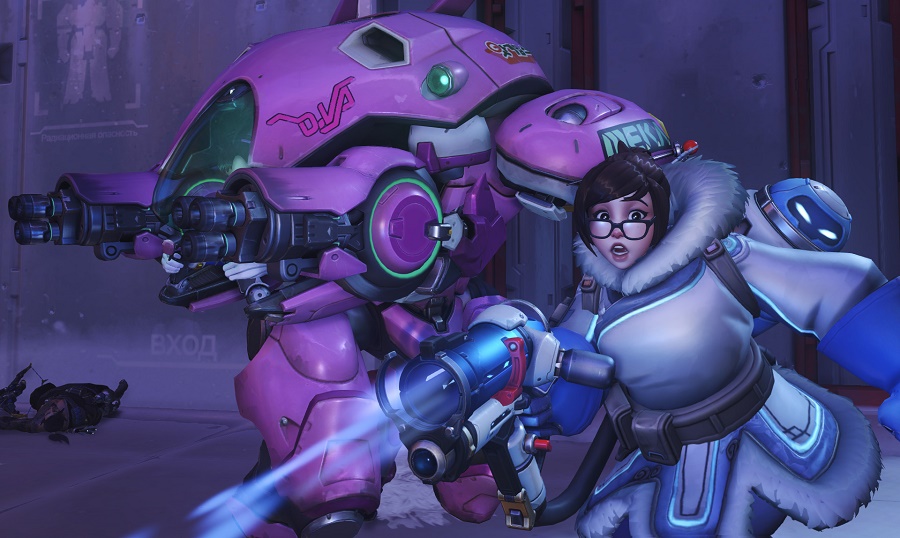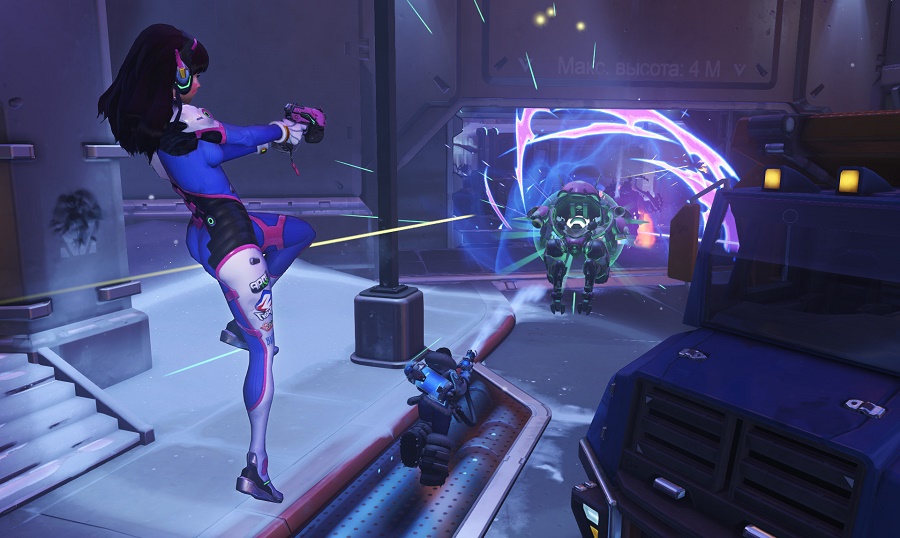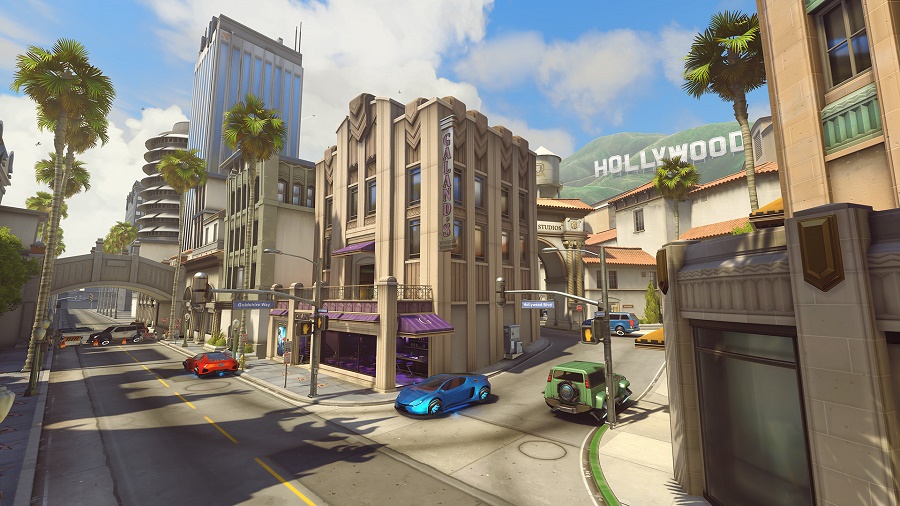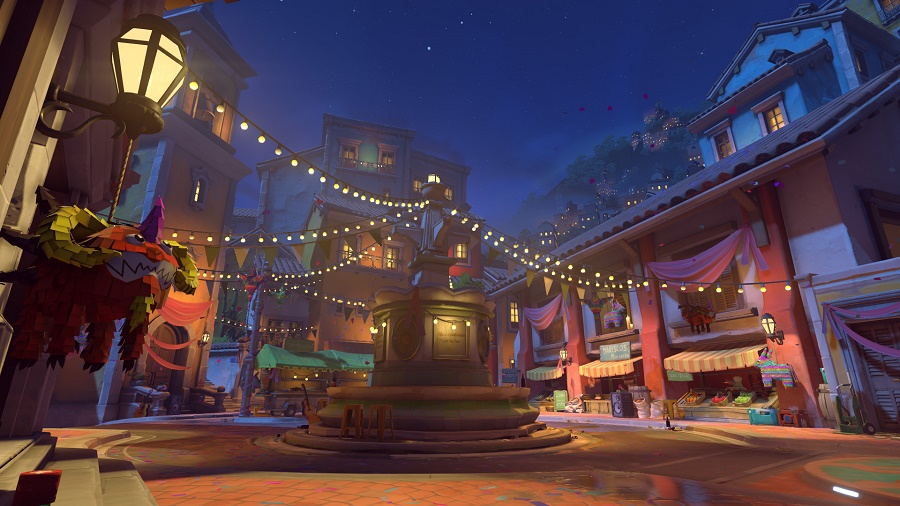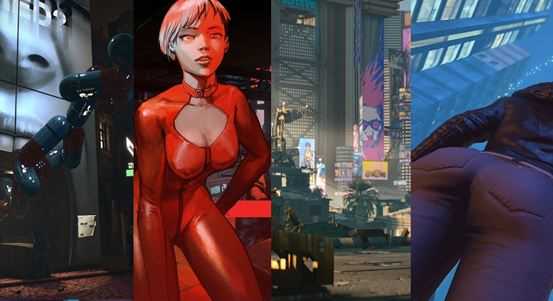Anyone who was a part of the last console generation might remember the “war” between Infamous and Prototype (or inFamous and [PROTOTYPE] if you’re a stickler for stylized capitalization and pointless punctuation) as both games launched around the same time and were both superpower-fueled sandbox extravaganzas. As I begin to write my review today, the similarity between then and now with Overwatch and Battleborn isn’t lost on me, even if the comparison is a little less accurate than the one that eventually lead to a lingerie photo shoot showdown between Cole MacGrath and Alex Mercer. Now that being said, should Blizzard and Gearbox feel the need to pit their protagonists against one another in nothing but their unmentionables for the sake of tradition, might I humbly suggest Mercy and Phoebe for their respective properties?
All kidding aside, having recently reviewed Battleborn, I was excited at the prospect of comparing the two games since everyone else online has seemed so keen to do so. However, as Total Biscuit himself recently declared, there’s really so few similarities between the two games that it’s really unwarranted. Aside from being First Person Shooters that advertise playing as “heroes” instead of “classes” or “characters,” Overwatch is a strictly multiplayer affair, focusing on a very specific experience instead of ticking off boxes on a checklist of demographics to which Blizzard wishes to appeal.
Being a competitive multiplayer game and essentially nothing else, Overwatch has no campaign, story missions, or even horde mode of which to speak. This makes it a bit of an odd duck, even if not in a way that’s necessarily bad. To elaborate, a great deal of thought and attention to detail clearly went into the character designs and animations, but there’s no actual backstory to showcase them…in the game, at least. I found the vast majority of the cast to be fascinating and wanted to know more about them, to know more about what brought them into this fight and what the sides of whatever this conflict are, but the only way I could find out more was online videos, information on Wikis, and reading outside lore. I suppose that’s fine in an age where nearly everyone is perpetually connected to everything online, but I can’t give the game credit for what it didn’t do, and all it did was make me wonder and never provide a truly satisfying explanation of who is doing what or why.
Prior to the game’s launch, a friend of mine kept insisting that Overwatch had to have some kind of campaign in it based on nothing more than the hype videos Blizzard’s marketing team had been releasing, but she was, unfortunately, quite wrong. I’m hardly docking points from the game’s score for it, but it did disappoint me. Widowmaker, Tracer, and Winston, just to name a few of the 21 characters on the current roster, each have excellent backstories that lead to their involvement with or against Overwatch (the group, not the game of the same name), and as I read about said stories all I could say to myself was “Gosh that would have been a fun mission to play.”
“The world needs heroes,” Overwatch’s tagline insists, without any inclination for what they’re needed. I suppose they’re needed to capture control points, but I digress.
Story-free gameplay (with the exception of a few quips) aside, Overwatch pits two teams of six against one another in one of three and a half game modes, those being Assault, Escort, Control, and Assault/Escort. Assault is fairly straight forward, featuring an attacking team and defending team. The attackers need to capture an Alpha and Bravo point, first one and then the other, by standing inside it unopposed. Up to three players can stand inside a capture point to speed the capture process up, while anyone from the defending team also standing in the capture point will freeze its progress until only one team is standing within to accelerate or stop the capture. Once the Alpha point is captured, both teams move to Bravo point for either a decisive victory or a harrowing last stand. Escort also involves attackers and defenders, but in this game mode, the attacking team must move a barge of some description through a predetermined path in the stage to various checkpoints to extend the game’s time limit and enable them to reach the final checkpoint and win the game. They do this by standing in close proximity to the payload, and similarly to capturing points, up to three players can stay in close proximity for maximum movement speed, while the defenders, obviously, need only prevent them from doing so. If the defenders can keep the attacking team from even reaching said payload, however, it will start to move backward, turning Escort into a reverse tug-of-war of sorts. Assault/Escort is obviously a combination of both game modes, with capturing the first (and only) point unlocking the payload to be moved forward for victory. Control varies the most, as both teams must play offense and defense at the same time in a best-of-three “King of the Hill” style match to see who can control the “hill” for 100 points worth first.
In total, there are 12 maps to play on, each with a set game mode, and all of them a part of Overwatch’s standard “Quickplay” matchmaking game rotation. You may have noticed the absence of a “team deathmatch” or any sort of kill-or-be-killed style mode, which was intentional on the part of Blizzard. Overwatch has a very clear focus on teamwork and cooperation as much as competition, which I found very refreshing and fun. It was reassuring to know that if I was having a bad game playing as, say, Pharah (a jetpack commando with a rocket launcher) or Widowmaker (the de facto sniper) I could switch to Mercy (the healer) and still be useful assisting my teammates. Being able to change your character on the fly (by retreating to your starting area) or after death means that you can adapt to the pace of the game and change your strategy appropriately, which is absolutely necessary for a multiplayer game to stay competitive. Whether or not your teammates will be willing to change instead of steadfastly refusing to stop playing as their favorite character is another issue entirely, of course, but one outside the realm of Blizzard’s control.
The roster that I briefly mentioned before has just as much diversity of gameplay as it does diversity of character design. There are four types of heroes, those who are attackers, defenders, tanks (soaking up damage and attention) and support specialists (healers or shielders), and there are multiple attackers, defenders, tanks, and healers from which to choose. One of the best examples of this diversity comes from the support heroes, featuring a techno Valkyrie with a healing staff reminiscent of the Team Fortress 2 medic’s healing ray, a bard-like DJ whose music grants a healing aura, a robotic monk with healing orbs that can be commanded to follow and restore a specified ally, and a cyberpunk architect who can grant regenerating shields to her teammates. Are you lousy using Widowmaker’s sniper rifle? Try Hanzo’s longbow. Are you having a bad game defending with Bastion? Try redirecting and stopping the attackers cold with Mei’s ice wall and freeze gun. There will be at least one character you will be comfortable using and excel with, and each is both welcoming and accessible to newcomers without sacrificing an ounce of depth for those who plan to keep playing well into the hundreds of hours.
While the roster feels nearly perfect with its wide variety of characters, their balancing between one another, and their diverse sets of talents, the current selection of maps and game modes leaves me somewhat disappointed. That isn’t to say that the current stages are bad or that the game modes aren’t fun. As a matter of fact, I rather like every map and I enjoy the game modes immensely, but it does feel somewhat small for a game that is strictly a multiplayer game. I can’t speak for any sort of online community, but I would have loved to have a Capture the Flag mode, or a Control mode with multiple simultaneous control points. I actually have no objection to the current number of maps, but having more game modes would necessitate more maps by design since Blizzard constructed each map around a specific game mode. That really shows in a great way, too. Nooks, crannies, secret alleys, shortcuts and side passages dot each stage, and demonstrates two things: how just knowing your terrain could make the difference between a win and a loss, and how thoughtful Blizzard was with their level design.
Visually, I would dare to say that Overwatch is a treat for the eyes. It has a style similar to some of my favorite Pixar films, albeit with an emphasis on more realism (with the exception of a few characters like the massive Roadhog and Reinhardt, of course). The game doesn’t focus on being the absolute bleeding edge of graphics technology, but rather to be uniquely beautiful, and it succeeds brilliantly in this with both stages and characters which are vivid and lively. Even the grim Reaper (pun intended) has more vibrancy in his visage than the most colorful character in 2016’s DOOM (and that’s no knock on DOOM, just an example of contrasting styles).
The audio is similarly well crafted, with enjoyable music that can be heroic and inspiring, or tense and nerve-wracking, depending on whether you’re winning or losing your current match. Sound effects, character dialogue, and strategic call-outs are wisely emphasized enemy first, so you’ll hear your adversary’s footsteps more heavily than your ally’s. This contributes to Overwatch’s excellent use of surround sound to give a truly three dimensional feel to gameplay, with audio that matches the multi-tiered, multi-layered arenas in which you’ll do battle. The character voices also feel spot on, with many characters having fun and unique accents to further differentiate them from one another, and not only does this give them more personality, but it helps your awareness, too. If I had a D.Va and Mei on my team at the same time, I never had to guess which one was where when I heard a callout from my flank.
Years ago, on the original Xbox, one of my favorite multiplayer games was Return to Castle Wolfenstein: Tides of War, and when I got an Xbox 360, Team Fortress 2 quickly became my favorite multiplayer game on that platform. That favoritism persisted once I got a gaming PC and saw the tremendous support that TF2 enjoyed on Steam (and still does to this day). To say that class-based multiplayer shooters have a soft spot in my heart would be an understatement, and nothing in that genre has captivated my attention quite like TF2…until Overwatch. In many respects I consider it a spiritual successor to what has become Valve’s “hat collection simulator with multiplayer elements.” The changes are welcome ones and in many cases feel like a natural evolution and expansion of what TF2 did right.
I also quite enjoy having a casual eSport feel to the post game carnage report, showing the “play of the game” and giving players a chance to vote for which of their peers had the most respectable performance. Mostly bolstering you ego, these votes only grant you a bit more experience toward ranking up, and while ranking up is ultimately meaningless, I consider that a positive. The cosmetic unlocks you receive for each rank (or for spending money on loot boxes if you’re an impatient sort) are fun without hurting game balance in favor of the higher level players.
Were I a god with nigh-omnipotent power, I would make only a few changes, but change things I would. I would give players a chance to experience each character’s backstory through gameplay. I would explain, possibly by using cutscenes during loading screens, why a payload or objective is important to which side and give a story to the battle. I would add splitscreen play for the console versions of the game, especially for matches against AI if not Quickplay and AI both. Finally, I would add a few more game modes and possibly expand matchmaking to allow players to choose a specific game mode to play. Those are nits that were very hard to pick, however, and two out of the four nits are rooted in personal preference more than an objective evaluation. Does Overwatch need a story mode? No, it’s perfectly functional for players interested in the story to find it elsewhere. Does Overwatch need more game modes, maps, or matchmaking options? Does it need splitscreen gameplay? Your mileage may vary on those, but I do think it would improve the weakest links in an otherwise unbreakable chain. Fortunately, Blizzard has claimed that they have big plans for ongoing support for Overwatch, and if they follow through with these claims for free as promised, Overwatch will grow into a 10 out of 10 game in short order.
The world needs heroes, and as it stands, Overwatch is polished, seemingly technically flawless, and most importantly…unapologetically fun. For a video game, it’s hard to be much more heroic than that.
Score: 9 / 10
Review code supplied by Microsoft Xbox.

